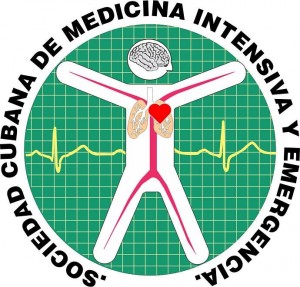Caracterización de pacientes con síndrome de distress respiratorio agudo en la unidad de cuidados intensivos / Characterization of patients with acute respiratory distress syndrome in intensive care unit
Palabras clave:
Síndrome de distress respiratorio agudo, ventilación protectora, presión positiva al final de la espiración, definición de Berlín, mortalidad /, Acute respiratory distress syndrome, lung-protective ventilation, positive end-expiratory pressure, Berlin deResumen
Introducción: El Síndrome de Distress Respiratorio Agudo (SDRA) es relativamente frecuente en cuidados intensivos.
Objetivo: Caracterizar a los pacientes que presentaron SDRA en la unidad de cuidados intensivos del Hospital Enrique Cabrera, en el período entre marzo 2012-2014.
Método: Se realizó un estudio descriptivo, observacional y prospectivo en 101 pacientes con SDRA. Las variables cuantitativas se resumieron mediante la media aritmética y la desviación estándar, valores mínimos y máximos. Las variables cualitativas fueron resumidas en porcentajes. Para identificar diferencias estadísticamente significativas entre las categorías de algunas de las variables estudiadas se confeccionaron tablas de contingencia y se obtuvo el valor de prueba estadística de Chi cuadrado con un intervalo de confianza del 95% (p=0.05).
Resultados: La neumonía representó el 56.4% de las causas de SDRA, los pacientes con SDRA ligero egresaron vivos en el 85.7%; aquellos pacientes que no presentaron complicaciones egresaron vivos el 91,7%. El 33% de las complicaciones fueron neumonías asociadas a ventilación. Los pacientes con APACHE II mayor de 19 puntos tuvieron una mortalidad de 76% y con ventilación mecánica mayor de 19 días de 83,3%.
Conclusiones: La neumonía fue la principal causa del SDRA. La media de la relación PO2/FIO2 fue de 196.6 ± 69.9 y de la PEEP de 8,5 ± 3,3 cm H20. Los pacientes con distréss severo, los que presentaron graves complicaciones, tres o más órganos en falla, APACHE II ≥ 20 puntos y ventilación por 20 o más días presentaron mayor mortalidad.
Abstract:
Introduction: Acute Respiratory Distress Syndrome (ARDS) is relatively frequent in intensive care.
Objective: To characterize the patients who presented ARDS in the intensive care unit at Enrique Cabrera Hospital in the period of time between March 2012-2014.
Method: A descriptive observational and prospective study in 101 patients with ARDS was performed. The quantitative variables resulted by mean arithmetic and standard deviation and by minimal and maximum values. The qualitative variables were offered in percentage. Statistically significant differences between the categories of some of the studied variables were identified by contingency tables and the statistical test value (X2) was obtained with a trusting interval of 95% (p=0.05).
Results: Pneumonia represented 56.4% of ARDS causes, the patients with mild ARDS were discharged alive in 85.7%; those patients who did not present complications were discharged alive in 91.7%. The complications were pneumonia associated to ventilation in 33%. The patients with APACHE II more than 19 points had a mortality of 76% and with mechanical ventilation more than 19 days a mortality of 83.3%.
Conclusions: The main ARDS cause was pneumonia. The medium value of PO2/FIO2 relation was 196.6 ± 69.9 and PEEP was 8.5 ± 3,3 cm H20. Patients with severe distress, who presented serious complications, three or more organs failure, APACHE II≥ 20 points and ventilation for 20 or more days presented higher mortality.
Descargas
Citas
1. Ashbaugh DG, Bigelow DB, Petty TL, Levine BE. Acute respiratory distress in adults. Lancet. 1967; 2: 319-23.
2. Raineri VM, Rubendfeld GD, Thompson BD, Ferguson ND, Caldwell E, Fan E, et al. The ARDS Definition Task Force. Acute respiratory distress syndrome: The Berlin Definition. JAMA. 2012; 307(23): 2526-33.
3. Walkey JA, Summer R, Davis J, Meade M, Chang S. Acute respiratory distress syndrome: epidemiology and managemet approaches. Clinical Epidemiology 2012; 4: 159-69.
4. Tomicic V, Fuentealba A, Martínez E, Graf J, Batista BJ.The basics on mechanical ventilation support in acute respiratory distress syndrome. Med Intensiva.2010; 34(6): 418-27.
5. Pierrakos C, Karanikolas M, Scolletta S, Karamouzos V, Velissaris D. Acute respiratory distress syndrome: pathophysiology and therapeutic options. J Clin Med Res.2012; 4(1): 7-16.
6. Torres DA, Ballesteros DA, Alvares RA, Llaguno LN. Factores Pronosticos en el Distress. Rev Cub Med Int Emerg. 2007; 6(2):679-92.
7. Heffernan DS, Dossett L.A. Gender and ARDS in Critically Injured Adults: A Porspective Study. J Trauma, 2011; 71: 878-85.
8. Fishman P, Elias A, Fishman J, Grippi MA, Pack AI. Fishmans Pulmonary Deseases and Desorders.4ta ed.vol 2 New York, The McWraw-Hill Company 2008.
9. Brown L, Kallet R, Matthay M, Dicker R. The influence of race on the development of acute lung injury in trauma patients. Am J Surg.2011; 201(4): 486-91.
10. Bajwa E, Cremer P, Gong M, Zhai R, Su L, Christiani D, et al. An NFKB1 promoter insertion/deletion polymorphism influences risk and outcome in acute respiratory distress syndrome among Caucasians. Plos One.2011; 6(5): e19469.
11. Taborda L, Barros F, Fonseca V, Irimia M, Carvalho R, Ramos A, et al. Acute respiratory distress syndrome: case series, two years at an intensive care unit. Act Med Portuguesa.2014; 27(2): 211-17.
12. Sigurdsson MI, Sigvaldason K, Gunnarsson TS, Moller A, Sigurdsson GH. Acute respiratory distress syndrome: nationwide changes in incidence, treatment and mortality over 23 years. Acta Anaesthesiol Scand. 2013; Vol. 57 (1): 37-45.
13. Allen BG, Parsons EP. Respiratory Failure Part II: Acute Respiratory Distress Syndrome. En: Irwin RS, Rippe JM, editors. Irwin and Rippe,s Intensive Care medicine. 7maed. Massachusetts: Lippicott Willians& Wilkins; 2011. p. 494-511.
14. Barbas C, Isola A, Farias AM, Cavalcanti A, Gama AM, et al. Brazilian recomendations of mechanical ventilation 2013. Part I. Rev Bras Ter Intensiva. 2014; 26(2): 89-121
15. Villar J, Blanco J, Añón J, Santos-Bouza A, Blanch L, Kacmarek R, et al. The ALIEN study: incidence and outcome of acute respiratory distress syndrome in the era of lung protective ventilation. Intensive Care Med.2011; 37(12): 1932-41.
16. Irish Critical Care Trials Group. Acute lung injury and the acute respiratory distress syndrome in Ireland: a prospective audit of epidemiology and management. Crit Care.2008; 12(1): R30.
17. Chiew Y, Chase J, Shaw G, Sundaresan A, Desaive T. Model-based PEEP optimisation in mechanical ventilation. Biomed Eng Online.2011; 101-11.
18. Briel M, Meade M, Mercat A, Brower R, Talmor D, Guyatt G, et al. Higher vs lower positive end-expiratory pressure in patients with acute lung injury and acute respiratory distress syndrome: systematic review and meta-analysis. Jama.2010; 303(9): 865-73.
19. Sánchez Padrón A, Torres Puga M, Pérez Ayala JL, Díaz Alonso T, González Salazar T, Zamora Quiñones A. Factores Pronósticos en el Distress Respiratorio Agudo. Reb Cub Med Int Emerg. 2003; 2:46-54.
20. Linko R, Ylinen R, Karlsson S, Roukonen E, Varpula T, Pettila V, et al. One-year mortality, quality of life and predicted life-time cost-utility in critical ill patients with acute respiratory failure. Crit Care. 2010; 14: R60.
21. Lu S, Cai S, Ou C, Zhao H. Establishment and Evaluation of a Simplified Evaluation System of Acute Respiratory Distress Syndrome. Yonsei Med J. 2013; 54(4): 935-41.
22. Seeley E, McAuley DF, Eisner M, Miletin M, Matthay M, Kallet RH. Predictors of mortality in acute lung injury during era of lung protective ventilation. Thorax.2008; 63(11): 994-98.







